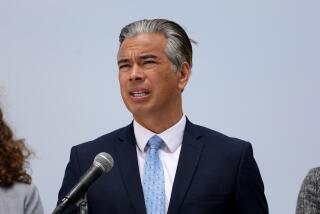Lockheed’s Suppliers Are Blamed in Toxic Exposure Case : Court: An attorney in the retrial says chemical firms showed ‘a careless disregard’ of workers’ rights.
- Share via
A lawyer for Lockheed workers claiming health damage from toxic exposures Tuesday blamed the defense giant’s chemical suppliers, telling a Los Angeles jury that the suppliers failed to provide adequate warnings of the danger of their products.
In his opening statement in the Superior Court retrial of the marathon toxic exposures case, attorney Thomas V. Girardi said the chemical firms showed “a careless disregard of the rights” of the workers, who helped manufacture military aircraft at Lockheed’s Burbank complex from the 1960s through the 1980s.
“They (the chemical suppliers) put chemicals out there that cause cancer, and they knew it,” Girardi said. “They put chemicals out there that cause central nervous system damage, and they knew it.”
The question for jurors is: “Did they give proper notice of these kinds of problems, or did they not?” Girardi said.
The 624 current and former Lockheed workers are seeking unspecified damages from two dozen chemical companies that supplied the solvents, resins and adhesives used to build the Stealth bomber and other planes.
In a trial expected to last at least several weeks, the workers are claiming they suffered injuries ranging from skin irritation to cancer because the chemical firms concealed the dangers of their products.
The chemical firms--including such giants as Exxon, DuPont, Arco and Unocal--say they provided adequate health warnings to Lockheed, which was responsible for the safety of its employees.
The first trial lasted eight months and ended last spring in a mistrial following the longest jury deliberations in a civil case in U. S. history. After 12 weeks of often bitter debate, jurors managed to reach only a few minor verdicts, and were deadlocked on the central questions: Were the workers actually injured by chemical exposure, and were inadequate warnings the cause?
The current trial, like the first, involves the health claims of 14 “pilot” plaintiffs only. Attorneys on both sides hope the outcome will trigger settlements or dismissals of many other claims, though more trials are possible.
*
In an effort to simplify the retrial, Judge Richard C. Hubbell has divided it into two parts. In the phase that began Tuesday, jurors are to decide which firms supplied chemicals to Lockheed, and whether the warnings they furnished were adequate.
In the second phase, jurors will decide if the 14 pilot workers were injured in the way that they claimed, and if inadequate warnings were the cause.
Lockheed was an original defendant, but agreed to a $33-million settlement before the first trial started in August, 1992. That fact has not been disclosed to jurors to avoid influencing their verdict on the liability of the chemical firms.
In his opening statement, Girardi tried to show that the companies soft-pedaled health risks in the warning labels, or material safety data sheets, they furnished with their products--and began giving complete information only after workers were exposed for years.
As an example, he read from an American Cyanamid warning label in 1979 that said its corrosion inhibiting primer “may cause irritation of eyes, nose and throat.” The label in 1985 for the same product revealed that it “has been shown to cause cancer in laboratory animals,” Girardi said.
Typically, the chemical firms “warned of eye irritation and other things that don’t make a big difference to a worker out there trying to earn a living,” Girardi said. The more severe warnings “they didn’t give until much later.”
But defense lawyers, who began their opening statements Tuesday, claimed the product warnings were updated as scientific knowledge increased. In any event, they said, the information was not intended for individual workers but for Lockheed--which was responsible for providing a safe workplace.
They said Lockheed often blended common solvents to make its own secret formulations, reducing their responsibility further.
More to Read
Inside the business of entertainment
The Wide Shot brings you news, analysis and insights on everything from streaming wars to production — and what it all means for the future.
You may occasionally receive promotional content from the Los Angeles Times.










